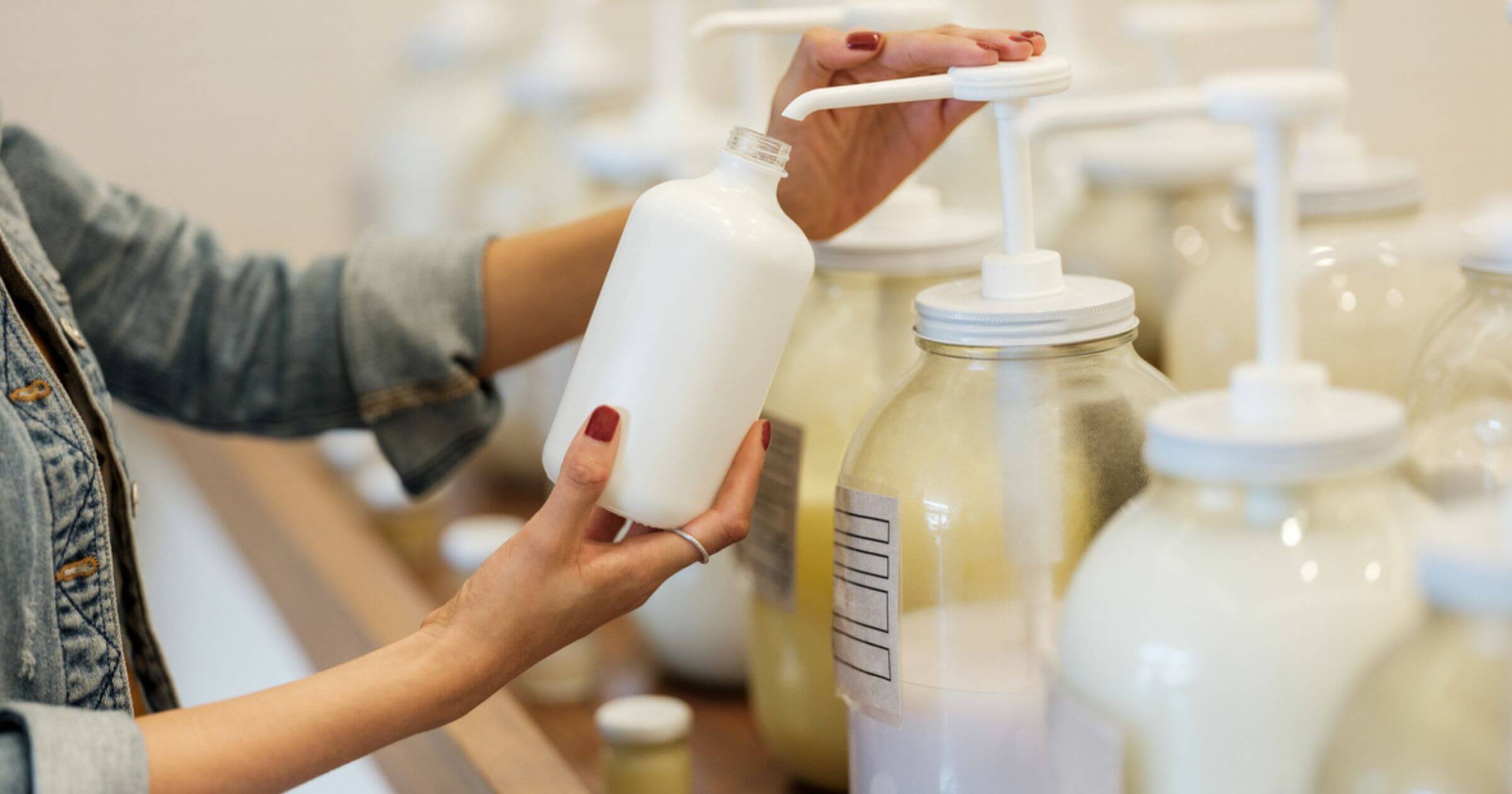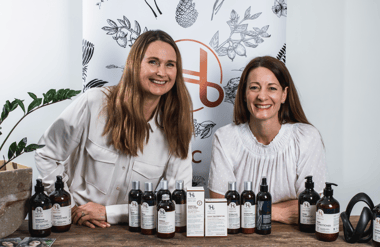
Beth Howell
Beth has been writing about the environment and climate change for over four years now – with her work being featured in publications such as The BBC, Forbes, The Express, Greenpeace, and in multiple academic journals.
The beauty industry has a mountain of waste to deal with, creating around 120 billion packaged products every single year — with just 14% of them getting recycled.
Thankfully, the scale of the problem hasn’t deterred cosmetics innovators from trying to tackle it.
These nine companies are excellent examples of how beauty brands can reduce their impact on the environment, from the top to the bottom of the supply chain.
Want to find out how your beauty brand can reduce plastic waste? Check out our guide on Sustainable Strategy for Beauty Brands, where you can find advice on how to reduce your plastic packaging, the benefits of introducing a greener strategy, and guidance on the first steps.
What's on this page?
01 | Best for: Working towards a zero-waste model02 | Best for: Rethinking production at ground-level
03 | Best for: Refilling, recycling, and rewarding
04 | Best for: Reducing ingredient waste
05 | Best for: Mitigating the impact of pollution
06 | Best for: Accountable improvements
07 | Best for: Introducing less waste, better transport initiatives
08 | Best for: Taking post-consumption control
09 | Best for: Integrating beauty into the circular economy
Summary: The best sustainable beauty brands
|
Brand |
Best for |
|
Sunday Riley |
Working towards a zero waste model |
|
Prose |
Rethinking production at ground-level |
|
Kiel’s |
Refilling, recycling, and rewarding |
|
Upcircle Beauty |
Reducing ingredient waste |
|
La Mer |
Mitigating the impact of pollution |
|
BABOR |
Accountable improvements |
|
Thrive Causemetics |
Introducing less waste, better transport initiatives |
|
Derma E |
Taking post-consumption control |
|
Lush |
Integrating beauty into the circular economy |
1. Sunday Riley
Best for: Working towards a zero-waste model
Sunday Riley is tackling sustainability from all angles. So far, it’s donated profits towards plastic recovery, tree planting, and preventing wildfires, whilst also making its transportation as eco-friendly as possible.
But the area this company excels in is its zero-waste attitude.
As one of the largest producers of cosmetic oils in America, Sunday Riley deals in massive amounts of seeds. Oil represents a small fraction of each seed’s makeup, leaving 90% of the material susceptible to waste.
Instead, that material is turned into animal food supplements and natural fertilizer, closing the loop on the raw material by returning it to the soil.
Since 2020, Sunday Riley has also been making sustainable swaps in its packaging. For example, it switched foam trays to recycled pulp board, and also utilizes eco-friendly inks (like soy), and FSC-approved (Forest Stewardship Council) materials for boxes.
On top of all this, Sunday Riley has achieved “plastic neutrality” (contributing zero net plastic to the global economy) by partnering with CleanHub and committing to collect over 110,000 lbs of plastic from vulnerable countries, where it’s most likely to end up polluting the coastline.
2. Prose
Best for: Rethinking production at ground-level
Custom hair-care company Prose is addressing the waste challenge by producing less in the first place.
Over-stocking products is a common hurdle for the cosmetics industry, with research showing that average inventory accuracy in the beauty sector rarely exceeds 50%.
That’s why Prose has adopted a made-to-order model, creating products tailored to individuals rather than one-size-fits-all shampoos and conditioners. The result? They’re only producing what people will actually use.
Sustainability goes hand in hand with customization. That’s to say they’re both core to Prose’s DNA.
This efficient production model has so far saved over 5 million sheets of paper and roughly 2.3 million bottle pumps, and has reduced emissions by around 47% per revenue.
Prose is also actively looking for ways to repurpose leftover materials from the production process. They even donated post-industrial materials, such as pallets and boxes, to build an adventure playground in Brooklyn, New York.
Want to find out more ways to make cosmetics eco-friendly? Check out our page: Top 9 Ways to Reduce Plastic Waste in the Cosmetics Industry.
3. Kiehl's
Best for: Refilling, recycling, and rewarding
Packaging is estimated to account for 70% of the cosmetics industry’s overall waste. That’s why skincare titan Kiehl’s is taking the “three R’s” approach – reducing, reusing, and recycling — in their pipeline.
The company is handling the first R (reducing) under its “Future Made Better” plan, cutting its reliance on virgin materials by crafting packaging that’s made of at least 80% recycled material.
Reusing items is on the agenda, too. In 2020, the brand unveiled “The Refillery” — a concept store that encourages customers to bring in refillable containers or buy a reusable aluminum bottle.
The brand estimates that the introduction of refillable pouches will also cut their plastic use by about 80%.
Customers can also use the “Recycle & Be Rewarded” program by returning empty Kiehl’s containers — and plastic packaging from any other skincare brand — to earn points that can be used as discounts on future purchases.
Incentivisation has worked in other companies too, with deposit return schemes regularly achieving recycling rates of around 80%. By eliminating the need for material sorting from the recovery process, such schemes provide reprocessors with material free of contamination.
4. UpCircle Beauty
Best for: Reducing ingredient waste
You know the old saying “waste not want not”? Well, UpCircle Beauty pretty much embodies that with their approach to ingredients used in products.
In a bid to move towards a circular economy, this innovative company sources and rescues by-products from other industries, and puts them towards the production of their own range.
UpCircle uses mostly the by-products of the food and drinks industry, including juicing, coffee-making, and farming, to offset wastage in both the cosmetics industry and the food industry, where over a third of all food is lost every year.
For example, the UpCircle Night Cream is made with the antioxidant-rich extract of repurposed blueberries – a by-product of the blueberry juicing industry.
5. La Mer
Best for: Mitigating the impact of pollution
The key ingredient in La Mer’s famous “Miracle Broth” is sea kelp — surprising then, that it’s so sensitive to the health of our oceans.
The company’s Blue Heart Oceans Fund seeks to mitigate one of the outcomes of packaging waste: a polluted marine environment. The IUCN estimates that around 14 million tonnes of plastic now enter the ocean every year, causing significant damage to marine life.
La Mer also supports efforts to combat ocean acidification and funding regenerative marine farming organization GreenWave.
As for the future? La Mer is aiming to have over 75% of its product packaging to be recycled, recyclable, reusable, refillable, or recoverable by 2025.
6. BABOR
Best for: Accountable improvements
Like many other cosmetics brands, German skincare giant BABOR is interested in improving its packaging and product. What sets them apart is their commitment to accountability, which is reflected in their organizational structure.
The company has created a specific outline, labeled the Green Agenda 2025, which intricately looks at how the brand will lower its carbon footprint, reduce packaging, and use sustainable ingredients.
“The ambitious project is accompanied and coordinated by a cross-divisional sustainability board. It continuously questions processes and develops initiatives for even more sustainable work. This board was installed in 2020.” — BABOR
By creating an internal body to review and question their sustainability efforts, BABOR has built waste reduction into the company’s operations and structure – a strategy that could pay dividends in terms of concrete progress.
7. Thrive Causemetics
Best for: Introducing less waste, better transport initiatives
Thrive calls itself a “causemetics” brand because it donates a portion of every sale to community nonprofits.
But their ethical approach isn’t limited to social causes. The company recently announced the Bigger Than Beauty skincare range, which represents a shift towards less wasteful packaging.
Thrive isn’t alone in its move to reduce packaging waste, but its conscious effort to improve transport marks another efficiency boost in the cosmetics supply chain:
“New, less wasteful bottles and tubes will be made with either glass or 30% PCR materials, with a weight reduction of as much as 65% compared to earlier versions of our packaging.” – Thrive Causemetics
Paired with its option for carbon-neutral delivery, Thrive’s efforts could make a significant dent in unnecessary waste associated with ecommerce cosmetics delivery – the largest contributor to global greenhouse gas emissions.

8. Derma E
Best for: Taking post-consumption control
Variables in consumer education, recovery facility efficiency, and waste collection make it difficult to control what happens to products once they’ve been purchased and consumed.
That’s why natural skincare brand Derma E offsets its impact beyond the tail end of its value chain.
A certain level of waste is (currently) inevitable for most brands, but some companies, like Derma E, are mitigating the impact of the material that slips through the cracks by taking responsibility for their “plastic footprint”.
All of Derma E’s packaging is recyclable, but they recognize the limitations of waste management infrastructure in some countries. To combat this, the company has planned to recover 10,000 lbs of plastic that would otherwise end up in the ocean.
In the process, Derma E is doing far more than just reducing its plastic footprint. The plastic collection that it sponsors creates steady, dignified jobs for waste workers who traditionally face unhealthy working conditions and a lack of proper social benefits.
It’s a reminder that the waste crisis is just as much of a humanitarian challenge as it is an environmental hurdle.
9. Lush
Best for: Integrating beauty into the circular economy
We couldn’t write an article on the best sustainable beauty brand without mentioning Lush, could we?
This innovative brand has intertwined its environmental ethos into its business strategy since its inception in 1995, making it a true pioneer of sustainability in the beauty industry.
Lush mitigates the impact of its packaging waste by eliminating it at the source. In fact, 60% of its core range is “naked” – products like soap and shampoo bars that aren’t packaged at all. The company estimates that 40–50% of product cost goes into the way it’s wrapped, so that it increases margins while eliminating waste.
Eliminating the waste associated with poor retail forecasting and unnecessary packaging is an important strategy, especially when working towards a circular economy.
That’s why Lush created its Green Hub — a facility that:
- Granulates plastic as part of the brand’s closed-loop Bring it Back recycling scheme
- Treats wastewater from their manufacturing and laundry processes
- Repairs machinery to prevent purchasing new
The company also donates surplus products and lifestyle items to charities across the UK.
As a result, Lush was able to recycle 81% of its UK manufacturing waste from the facility in 2022, repair over 700 electrical items, and donate more than 107,000 products and lifestyle items to those in need.
Summary
Recyclable packaging has become something of a baseline expectation for cosmetics producers. It’s a development worth celebrating because packaging design sits at the nexus of the waste chain.
Without easily recyclable compacts, liquid pumps, and tubes, there’s less material to return to the circular economy for reuse – and more that ends up in landfills and the natural environment.
These innovative companies have recognized that recyclability is just one part of an incredibly complex waste chain. To make a measurable impact, they’ve looked beyond their products to the raw materials, natural environments, and company hierarchies they rely on.
Want to find out how your beauty brand can reduce plastic waste? Check out our guide on Sustainable Strategy for Beauty Brands, where you can find advice on how to reduce your plastic packaging, the benefits of introducing a greener strategy, and guidance on the first steps.
FAQs
How can beauty brands be sustainable?
There are a lot of ways beauty brands can be sustainable. Some of the most common things include:
- Switching to ingredients that are non-toxic for both humans and the environment
- Having energy-efficient manufacturing processes in place
- Reducing any unnecessary packaging on the production line — or switching to more sustainable materials
- Making sure they're cruelty-free
You can find out more in our Ultimate Guide to Sustainable Beauty.
What is an ethical beauty brand?
An ethical beauty brand focuses on sustainable practices with the well-being of animals, people, and the planet in mind.
That means any employees or partners have good working conditions, animals aren't exploited for the product, and the environment is prioritized.
What is greenwashing in beauty?
Greenwashing in the beauty industry is when a company falsely claims that a product, policy, or activity is more environmentally friendly than it actually is.
It’s a term used to describe misleading messages made by businesses that look like they have a positive impact on our planet.

.webp)

.webp?width=380&name=Cosmetics%20(1).webp)
.webp?width=380&name=Refill-beauty-product%20(1).webp)

.webp?width=380&name=trash%20(1).webp)


.webp?width=380&name=Shopping%20for%20sustainable%20beauty%20products%20(1).webp)
.webp?width=380&name=Paper-packaging%20(1).webp)
.webp?width=380&name=Dumped%20waste%20(1).webp)

